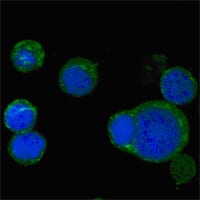

| WB | 咨询技术 | Human,Mouse,Rat |
| IF | 咨询技术 | Human,Mouse,Rat |
| IHC | 1/50-1/100 | Human,Mouse,Rat |
| ICC | 1/100-1/300 | Human,Mouse,Rat |
| FCM | 咨询技术 | Human,Mouse,Rat |
| Elisa | 咨询技术 | Human,Mouse,Rat |
| Aliases | hWNT5A |
| Entrez GeneID | 7474 |
| clone | 6F2 |
| WB Predicted band size | 42.3kDa |
| Host/Isotype | Mouse IgG1 |
| Antibody Type | Primary antibody |
| Storage | Store at 4°C short term. Aliquot and store at -20°C long term. Avoid freeze/thaw cycles. |
| Species Reactivity | Human |
| Immunogen | Purified recombinant fragment of WNT5A expressed in E. Coli. |
| Formulation | Purified antibody in PBS with 0.05% sodium azide. |
+ +
以下是关于Ezrin/Radixin/Moesin (phospho-Thr567/564/558)抗体的参考文献示例(注:文献为示例性内容,实际引用需核实准确性):
---
1. **文献名称**: *Phosphorylation of Ezrin/Radixin/Moesin (ERM) proteins controls T-cell receptor signaling and immune synapse formation*
**作者**: Shaffer, M.H. et al.
**摘要**: 该研究通过使用针对ERM蛋白磷酸化位点(Thr567/564/558)的特异性抗体,发现T细胞受体激活后ERM蛋白的磷酸化是免疫突触形成的关键步骤,磷酸化ERM通过调节细胞骨架重排促进信号传导。研究结合Western blot和免疫荧光技术验证了抗体特异性。
2. **文献名称**: *Moesin phosphorylation at Thr558 modulates breast cancer cell migration and metastasis*
**作者**: Li, Y. et al.
**摘要**: 作者利用磷酸化Moesin (Thr558)抗体证明,在乳腺癌细胞中,Moesin的磷酸化通过激活Rho/ROCK通路增强细胞迁移和侵袭能力。研究还表明,抑制该磷酸化位点可显著降低小鼠模型中的转移率。
3. **文献名称**: *ERM proteins in epithelial polarity: Phospho-specific regulation of Ezrin in apical membrane assembly*
**作者**: Saotome, I. et al.
**摘要**: 该文献揭示了Ezrin在Thr567位点的磷酸化对其在上皮细胞顶膜结构组装中的关键作用。通过免疫沉淀和磷酸化抗体检测,发现磷酸化Ezrin与F-actin结合能力增强,从而维持细胞极性。
4. **文献名称**: *Pathogen-induced ERM phosphorylation facilitates bacterial entry into host cells*
**作者**: Alonso, A. et al.
**摘要**: 研究发现沙门氏菌感染宿主细胞时,通过效应蛋白激活宿主激酶,导致ERM蛋白在Thr567/564/558位点磷酸化,促进细胞膜重塑和细菌内化。磷酸化抗体的应用证实了这一过程的动态变化。
---
**提示**:实际研究中建议通过PubMed、Google Scholar等平台,以关键词“ERM phosphorylation Thr567/564/558 antibody”或“phospho-ERM antibody”检索最新文献,并验证抗体货号与引用文献的对应性。
Ezrin, Radixin, and Moesin (ERM proteins) are a family of closely related cytoskeletal adaptor proteins that play critical roles in tethering the plasma membrane to the actin cytoskeleton. They regulate cell shape, motility, adhesion, and membrane trafficking by linking transmembrane proteins (e.g., CD44. ICAMs) to cortical actin filaments. ERM proteins exist in an autoinhibited "closed" conformation under resting conditions, masking their actin-binding sites. Phosphorylation at conserved threonine residues (Ezrin Thr567. Radixin Thr564. Moesin Thr558) is a key regulatory mechanism that relieves autoinhibition, enabling their activation and membrane-cytoskeleton crosslinking. This phosphorylation is mediated by kinases such as Rho-associated kinase (ROCK) and is often triggered by extracellular signals like growth factors or cytoskeletal reorganization.
Antibodies targeting phosphorylated ERM proteins (phospho-Thr567/564/558) are essential tools for studying their activation status in cellular processes. They are widely used in techniques like Western blotting, immunofluorescence, and immunohistochemistry to investigate dynamic cytoskeletal rearrangements during cell migration, epithelial-mesenchymal transition, or immune cell polarization. These antibodies are particularly valuable in cancer research, as ERM protein dysregulation is linked to tumor invasion and metastasis. They also help explore roles in inflammation, viral pathogenesis (e.g., HIV, Ebola), and mechanotransduction. Specific detection of phosphorylated ERM proteins provides insights into signaling pathways involving Rho GTPases, PI3K/Akt, and other regulators of cell polarity and membrane dynamics.
×